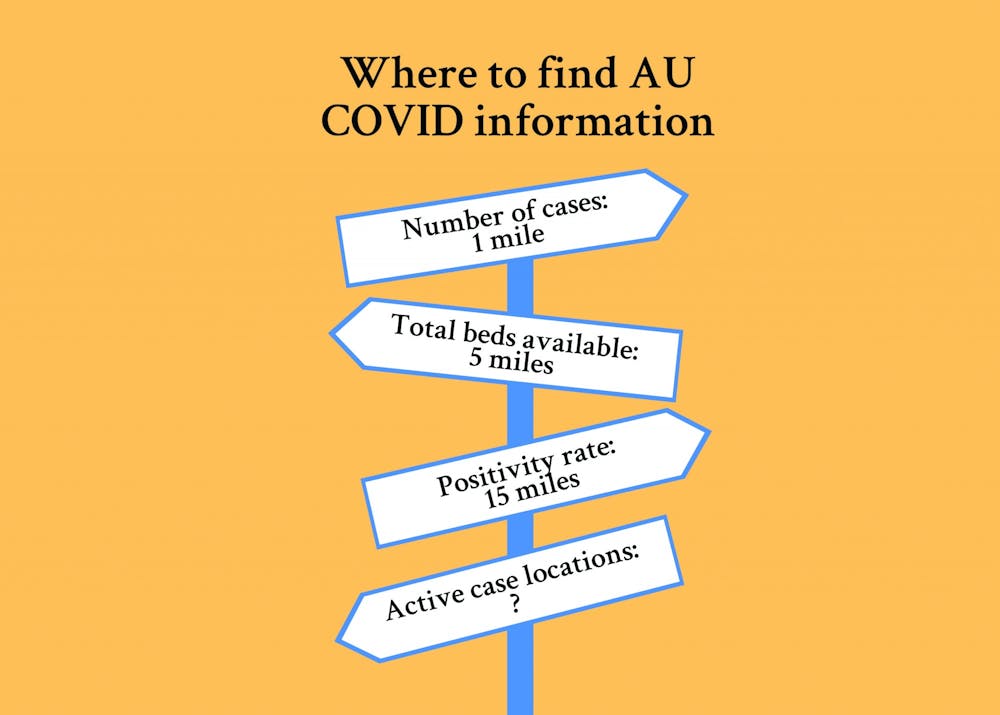With life on campus starting back up again, Auburn University and its students have entered into a sort of trust exercise with each other.
The threat of a COVID-19 outbreak looms over the school, constantly threatening to send us all back home, and the only way to stave it off is for the University, the faculty, the staff and the students to be honest and open with each other.
For this semester to work, it is essential that students make selfless, intelligent decisions regarding their health, and that the University regularly release timely, accurate data related to the presence of the virus on campus to ensure that those decisions can be informed decisions.
In short, we need to know how far away the dark cloud of a potential outbreak hangs above the Haley Center.
Right now, we don’t really know where that cloud is.
Late last week, Auburn University launched its COVID-19 Resource Center website.
As of now, this site is a collection of resources for students, faculty and staff who may have either tested positive for the virus or been in close proximity with someone else who has. It also includes a spreadsheet of the number of students, staff and “other” who have tested positive for the virus.
However, the information that the University is currently releasing is not adequate to detail the threat of a COVID outbreak on campus.
To start, the University has said it will only be updating the number of positive cases on campus once a week.
This is despite the fact that the University itself receives updated information from the AU Medical Clinic and the Alabama Department of Public Health every two days.
According to Preston Sparks, director of University communication services, this delay gives the University a chance to corroborate the reports it gets from a variety of sources before releasing information to the public.
“Updates are provided on a weekly basis to allot for needed time in confirming data from multiple sources,” he said.
The problem is that, as we have seen with a multitude of other colleges, businesses, cruise ships and communities, this virus has the ability to sweep through an area and significantly impact daily life in less than a week.
For instance, at the University of North Carolina, the positivity rate of COVID tests among students rose from 2.8% to 13.6% in their first week. This rapid spike sent UNC back to remote learning.
Now, UNC’s The Daily Tar Heel is reporting that there are more than 10 confirmed clusters of the virus on the school’s campus with hundreds of students in quarantine.
With a virus capable of spreading from a handful of people to hundreds of people in days, it is untenable for the University to only update the Auburn community on the threat of the virus once a week. Similarly, by the time the University provides data to the students and faculty, the virus has likely already expanded further into the population.
Not only is the University releasing data too slowly, they aren’t releasing it on any kind of centralized platform.
As of publication, the University has released the overall number of positive cases on its COVID-19 Resource Center, and it has released the number of available quarantine beds in a video with Dr. Fred Kam on Twitter.
Initially, the University and Sparks indicated that they would not be releasing the positivity rate of tests, but in an email on Monday, the East Alabama Medical Clinic said their positivity rate was 24% percent.
Kam has now confirmed that number in an email, but he says that the increased positivity rate is due to the clinic’s new streamlined testing procedure.
“The clinic is now focusing its COVID-19 testing on those with early symptoms of the disease or having had credible close contact to someone with COVID-19,” Kam said. “This has streamlined the testing process and thereby reduced the number of overall tests administered to those without symptoms or possible exposure who were likely to be negative. As such, with fewer likely negative tests being administered, the clinic’s positivity rate was affected.”
While it’s good that the University is either releasing or confirming these numbers, it’s concerning that they are doing so in such a hodgepodge fashion.
In the same vein, the University is also not providing any information related to the geographic location of these confirmed cases.
Currently, we don’t know how many of the 203 students who tested positive last week live on campus. We don’t know where they likely contracted the virus or where they went after that. We don’t even know if all of these cases are in similar places or if they are spread evenly across campus.
All of this information is vital for students and employees to have so that they can make informed decisions about their health. However, even if the University is technically releasing some of this information, making people hunt through various emails and tweets to find it isn’t very helpful.
To their credit, the University of Alabama System has far surpassed Auburn in this regard.
The UA System, like a large number of other universities across the country, has a regularly updated dashboard website that includes the number of positive cases on each of their campuses, the number of students who were tested and the percentage of quarantine dorms in use.
It’s all in one place.
UNC Chapel Hill has a similar page.
So do Troy University, Tuskegee and Georgia.
Why don’t we?
Since March, this fall semester was always going to be a trust exercise — an agreement between people and an institution they love to be honest and open with one another about the risks facing this community.
While Auburn is technically releasing some of the relevant data, they aren’t doing it in a way that’s timely or cohesive. Weekly updates and having to search through emails isn’t going to get us through this semester on campus.
Auburn students and employees deserve to know not just how many students have tested positive, but where those cases were and what the positivity rating was. Similarly, they deserve to know how many quarantine beds are being used and how many are still available.
More than that, students and employees deserve to have this information easily accessible and updated often.
Hopefully, the administrators who are making decisions about on-campus life already have this information easily available to them, but the rest of us don’t.
The rest of us have been left to dig through emails and pull data from a variety of sources.
We have, it seems, been left to sit, six-feet apart from each other, on The Greenspace, and watch for that dark and looming cloud.
If we’re lucky, it isn’t already here, but really, we don’t know.
Do you like this story? The Plainsman doesn't accept money from tuition or student fees, and we don't charge a subscription fee. But you can donate to support The Plainsman.





